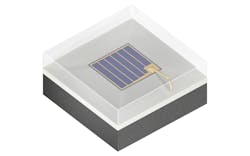In its continual development of packaged LEDs for specific applications, Osram has added a smaller infrared model to its Oslon line and is promoting it for gesture control of in-car navigation screens.
The new Oslon Piccolo chip is about 25% smaller than similar Oslon Black offerings, with the Piccolo chip itself measuring 0.75 mm2 (packaged in a 1.6-mm2 footprint) compared to the Black’s 1 mm2.
The LED’s shrunken dimensions increase the likelihood of its fitting into an onboard display screen.
“The advantages of the Oslon Piccolo really pay off when used in conjunction with indoor displays,” said Walter Rothmund, Osram Opto Semiconductors marketing manager for sensing. “Thanks to its extremely compact dimensions of only 1.6 mm × 1.6 mm and a package height of only 0.81 mm, the IRED can be installed easily in a small space.”
Gesture-control navigation systems activate controls only when a person points at the screen. They can be easier to use, and they can minimize the clutter of on-screen control icons.
Osram also positions some of the infrared chips in its Oslon Black line for gesture control uses, but the Black’s larger size means it is too big for some screens. In another car interior use, Osram is also positioning the Black (but not so much the Piccolo) for driver fatigue detection, where compact size is not as vital. Fatigue detection systems take note of changes in a driver’s eye movement or facial positions that can indicate tiredness.
Osram is offering the Piccolo in two frequencies. An 850-nm version offers almost twice the camera sensitivity of a 940-nm version, but the 850 emits a detectable red glow that may annoy motorists and passengers. The 940 eliminates the glow. Piccolo has a DC power rating of 1.15W at 1A and switching time of 10 ns.
Although visible-spectrum LEDs might also support gesture control, fatigue detection, and other non-illumination cabin functions, Osram uses infrared to avoid the distraction that visible light can cause.
Osram refers to its infrared LEDs as IREDs. With Piccolo and various permutations of the Oslon Black, it is striving to mix and match the right chip with the right application.
“We’re delivering the infrared light sources in various power classes as well as with different optics, to give our customers different choices to fit their systems,” an Osram spokesperson explained to LEDs Magazine. “Depending on the final application and of course depending on where the system will be integrated in the car interior, one IRED could fit better than the other. When you think of the mentioned scenario regarding gesture control of an interior display, components like the light source need to be as small as possible. When you think of it the other way round, of course it’s easier to reach higher output levels with a bigger chip. There are definitely applications within automotive interior where the size of the IRED isn’t that important — then you might choose one of the Oslon Black IREDs.”
In recent years, Osram has unleashed a bevy of LED chips — many of them infrared — aimed at particular non-illumination functions, such as the six Oslon Black chips it introduced in April 2018, some for car interior and others for car exterior functions.
In February 2018, the company introduced two infrared chips in its Synios line aimed at facial recognition to unlock phones and tablets, using 940 nm to eliminate glow of the earlier 850-nm Synios model. Later that year, an infrared chip in its Synios line was aimed at helping consumers use phones to detect the contents of food. Also in 2018, it introduced a near-infrared Oslon Black chip to help farmers detect when crops are ready to harvest.
In June 2017, Osram introduced the small footprint SFH 4055 LED that emits at 850 nm for use in augmented and virtual reality (AR and VR) applications.
Along the way, it has also added laser chips to the mix. In late 2018, for example, at around the same time of introducing even more facial recognition IREDs, it also introduced VCSELs (vertical cavity surface-emitting lasers) to provide three-dimensional facial recognition, a step up from the two dimensions of LEDs. That introduction came only a few months after Osram added other VCSELs for facial recognition.
The intention is to offer customers tradeoffs in price and performance. The VCSEL and other laser products can be costlier than LEDs.
Whether there is truly a sustainable market for the expansive product portfolio is another question. Osram markets its chips under a wide array of brands including Oslon (with several sub-brands), Synios, Duris, OsconIQ, SolerIQ, ChipLED, Displix, and others.
It’s all part of the company’s emphasis on photonics and digital technology over general illumination, a path it has been pursuing for a few years now.
As Osram starts to integrate itself with its new owner ams, it remains to be seen how the two companies will square overlaps in their product portfolios. AMS, an Austrian sensor maker, hopes to receive regulatory approval soon for the acquisition.
Editor’s note: Stay tuned for a feature in our June issue from Osram’s Kimberly Peiler on advances in automotive LED capabilities for improving the autonomous vehicle experience.
MARK HALPER is a contributing editor for LEDs Magazine, and an energy, technology, and business journalist ([email protected]).
For up-to-the-minute LED and SSL updates, why not follow us on Twitter? You’ll find curated content and commentary, as well as information on industry events, webcasts, and surveys on our LinkedIn Company Page and our Facebook page.






